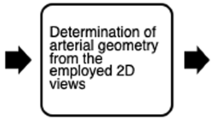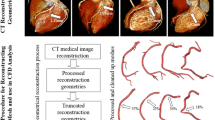Abstract
The purpose of this study is to investigate the effect of various degrees of percentage stenosis on hemodynamic parameters during the hyperemic flow condition. 3D patient-specific coronary artery models were generated based on the CT scan data using MIMICS-18. Numerical simulation was performed for normal and stenosed coronary artery models of 70, 80 and 90% AS (area stenosis). Pressure, velocity, wall shear stress and fractional flow reserve (FFR) were measured and compared with the normal coronary artery model during the cardiac cycle. The results show that, as the percentage AS increase, the pressure drop increases as compared with the normal coronary artery model. Considerable elevation of velocity was observed as the percentage AS increases. The results also demonstrate a recirculation zone immediate after the stenosis which could lead to further progression of stenosis in the flow-disturbed area. Highest wall shear stress was observed for 90% AS as compared to other models that could result in the rupture of coronary artery. The FFR of 90% AS is found to be considerably low.









Similar content being viewed by others
References
Asakura T, Karino T (1990) Flow patterns and spatial distribution of atherosclerotic lesions in human coronary arteries. Circ Res 66:1045–1066
Chaichana T, Sun Z, Jewkes J (2011) Computation of hemodynamics in the left coronary artery with variable angulations. J Biomech 44:1869–1878. doi:10.1016/j.jbiomech.2011.04.033
Chaichana T, Sun Z, Jewkes J (2012) Computational fluid dynamics analysis of the effect of plaques in the left coronary artery. Comput Math Methods Med
Chaichana T, Sun Z, Jewkes J (2012) Investigation of the haemodynamic environment of bifurcation plaques within the left coronary artery in realistic patient models based on CT images. Australas Phys Eng Sci Med 35:231–236
Chaichana T, Sun Z, Jewkes J (2013) Haemodynamic analysis of the effect of different types of plaques in the left coronary artery. Comput Med Imaging Graph 37:197–206. doi:10.1016/j.compmedimag.2013.02.001
Chaichana T, Sun Z, Jewkes J (2013) Hemodynamic impacts of various types of stenosis in the left coronary artery bifurcation: a patient-specific analysis. Phys Med 29:447–452. doi:10.1016/j.ejmp.2013.02.001
Cho YI, Back LH, Crawford DW, Cuffel RF (1983) Experimental study of pulsatile and steady flow through a smooth tube and an atherosclerotic coronary artery casting of man. J Biomech 16:933–946
Feng R, Xenos M, Girdhar G, Kang W, Davenport JW, Deng Y, Bluestein D (2012) Viscous flow simulation in a stenosis model using discrete particle dynamics: a comparison between DPD and CFD. Biomech Model Mechanobiol 11:119–129
Fuster V, Lewis A (1994) Conner memorial lecture. Mechanisms leading to myocardial infarction: insights from studies of vascular biology. Circulation 90:2126–2146
Glagov S, Weisenberg E, Zarins CK, Stankunavicius R, Kolettis GJ (1987) Compensatory enlargement of human atherosclerotic coronary arteries. N Engl J Med 316:1371–1375
Govindaraju K, Kamangar S, Badruddin IA, Viswanathan GN, Badarudin A, Salman Ahmed NJ (2014) Effect of porous media of the stenosed artery wall to the coronary physiological diagnostic parameter: a computational fluid dynamic analysis. Atherosclerosis 233:630–635. doi:10.1016/j.atherosclerosis.2014.01.043
Govindaraju K, Viswanathan GN, Badruddin IA, Kamangar S, Salman Ahmed N, Al-Rashed AA (2016) The influence of artery wall curvature on the anatomical assessment of stenosis severity derived from fractional flow reserve: a computational fluid dynamics study. Comput Methods Biomech Biomed Eng :1–9
Hau W (2004) Fractional flow reserve and complex coronary pathologic conditions. Eur Heart J 25:723–727. doi:10.1016/j.ehj.2004.02.019
Huo Y, Wischgoll T, Kassab GS (2007) Flow patterns in three-dimensional porcine epicardial coronary arterial tree. Am J Physiol Heart Circ Physiol 293:H2959–H2970
Johnston BM, Johnston PR, Corney S, Kilpatrick D (2006) Non-Newtonian blood flow in human right coronary arteries: transient simulations. J Biomech 39:1116–1128. doi:10.1016/j.jbiomech.2005.01.034
Jozwik K, Obidowski D (2010) Numerical simulations of the blood flow through vertebral arteries. J Biomech 43:177–185. doi:10.1016/j.jbiomech.2009.09.026
Kagadis GC, Skouras ED, Bourantas GC, Paraskeva CA, Katsanos K, Karnabatidis D, Nikiforidis GC (2008) Computational representation and hemodynamic characterization of in vivo acquired severe stenotic renal artery geometries using turbulence modeling. Med Eng Phys 30:647–660. doi:10.1016/j.medengphy.2007.07.005
Kamangar S, Badruddin IA, Badarudin A, Nik-Ghazali N, Govindaraju K, Salman Ahmed N, Yunus Khan T (2016) Influence of stenosis on hemodynamic parameters in the realistic left coronary artery under hyperemic conditions. Comput Methods Biomech Biomed Eng :1–8
Kamangar S, Kalimuthu G, Anjum Badruddin I, Badarudin A, Salman Ahmed NJ, Khan TMY (2014) Numerical investigation of the effect of stenosis geometry on the coronary diagnostic parameters. Sci World J 2014:7. doi:10.1155/2014/354946
Kern MJ, Samady H (2010) Current concepts of integrated coronary physiology in the catheterization laboratory. J Am Coll Cardiol 55:173–185. doi:10.1016/j.jacc.2009.06.062
Kim H, Vignon-Clementel I, Coogan J, Figueroa C, Jansen K, Taylor C (2010) Patient-specific modeling of blood flow and pressure in human coronary arteries. Ann Biomed Eng 38:3195–3209
Kirpalani A, Park H, Butany J, Johnston KW, Ojha M (1999) Velocity and wall shear stress patterns in the human right coronary artery. J Biomech Eng 121:370–375. doi:10.1115/1.2798333
Konala BC, Das A, Banerjee RK (2011) Influence of arterial wall-stenosis compliance on the coronary diagnostic parameters. J Biomech 44:842–847. doi:10.1016/j.jbiomech.2010.12.011
Ku DN (1997) Blood flow in arteries. Annu Rev Fluid Mech 29:399–434
Park S-J, Kang S-J, Ahn J-M, Shim EB, Kim Y-T, Yun S-C, Song H, Lee J-Y, Kim W-J, Park D-W, Lee S-W, Kim Y-H, Lee CW, Mintz GS, Park S-W (2012) Visual-functional mismatch between coronary angiography and fractional flow reserve. JACC: Cardiovasc Interv 5:1029–1036. doi:10.1016/j.jcin.2012.07.007
Peelukhana SV, Back LH, Banerjee RK (2009) Influence of coronary collateral flow on coronary diagnostic parameters: an in vitro study. J Biomech 42:2753–2759. doi:10.1016/j.jbiomech.2009.08.013
Pijls NH, Van Gelder B, Van der Voort P, Peels K, Bracke FA, Bonnier HJ, el Gamal MI (1995) Fractional flow reserve. A useful index to evaluate the influence of an epicardial coronary stenosis on myocardial blood flow. Circulation 92:3183–3193
Pijls NHJ, Sels J-WEM (2012) Functional measurement of coronary stenosis. J Am Coll Cardiol 59:1045–1057. doi:10.1016/j.jacc.2011.09.077
Ryou HS, Kim S, Kim SW, Cho SW (2012) Construction of healthy arteries using computed tomography and virtual histology intravascular ultrasound. J Biomech 45:1612–1618
Soulis JV, Giannoglou GD, Parcharidis GE, Louridas GE (2007) Flow parameters in normal left coronary artery tree. Implication to atherogenesis. Comput Biol Med 37:628–636
Sun Z, Dimpudus FJ, Nugroho J, Adipranoto JD (2010) CT virtual intravascular endoscopy assessment of coronary artery plaques: a preliminary study. Eur J Radiol 75:e112–e119
Swillens A, De Witte M, Nordgaard H, Løvstakken L, Van Loo D, Trachet B, Vierendeels J, Segers P (2012) Effect of the degree of LAD stenosis on “competitive flow” and flow field characteristics in LIMA-to-LAD bypass surgery. Med Biol Eng Comput 50:839–849
Tang D, Yang C, Zheng J, Woodard PK, Saffitz JE, Petruccelli JD, Sicard GA, Yuan C (2005) Local maximal stress hypothesis and computational plaque vulnerability index for atherosclerotic plaque assessment. Ann Biomed Eng 33:1789–1801. doi:10.1007/s10439-005-8267-1
World Medical Association Declaration of Helsinki (1997) Recommendations guiding physicians in biomedical research involving human subjects. JAMA 35:2–3. doi:10.1016/s0008-6363(97)00109-0
Zarins CK, Giddens DP, Bharadvaj B, Sottiurai VS, Mabon RF, Glagov S (1983) Carotid bifurcation atherosclerosis. Quantitative correlation of plaque localization with flow velocity profiles and wall shear stress. Circ Res 53:502–514
Acknowledgements
The authors would like to thank University of Malaya for funding the project under Grant Nos. RP006A-13AET and PG212-2015B.
Author information
Authors and Affiliations
Corresponding authors
Ethics declarations
Conflict of interest
There is no conflict of interest to declare for this work.
Rights and permissions
About this article
Cite this article
Kamangar, S., Badruddin, I.A., Govindaraju, K. et al. Patient-specific 3D hemodynamics modelling of left coronary artery under hyperemic conditions. Med Biol Eng Comput 55, 1451–1461 (2017). https://doi.org/10.1007/s11517-016-1604-8
Received:
Accepted:
Published:
Issue Date:
DOI: https://doi.org/10.1007/s11517-016-1604-8




